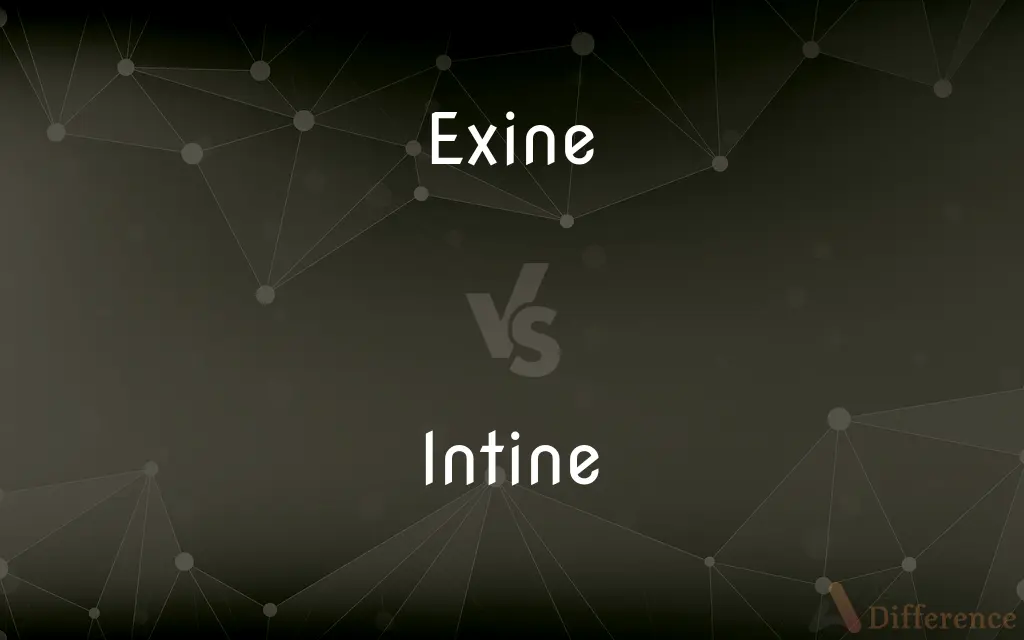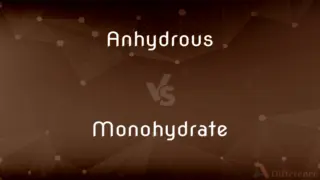Exine vs. Intine — What's the Difference?
Edited by Tayyaba Rehman — By Maham Liaqat — Updated on April 18, 2024
Exine is the tough, outer layer of a pollen grain, known for its durability and complex patterns, while intine is the inner, thinner layer that supports pollen tube growth.

Difference Between Exine and Intine
Table of Contents
ADVERTISEMENT
Key Differences
Exine is the outer layer of a pollen grain's wall, known for its resilience and role in protecting the pollen from environmental stresses. It is primarily composed of sporopollenin, one of the toughest known organic materials. Whereas, intine is the inner layer that is much thinner and primarily composed of cellulose and pectin, which aids in the flexibility and growth of the pollen tube necessary for fertilization.
The exine layer is characterized by its intricate patterning and sculpturing, which are species-specific and help in species identification and may play a role in the interaction with pollinators. On the other hand, the intine layer is generally smooth and lacks the complex patterns found in exine.
Pollen grains rely on the exine to withstand harsh conditions during transport from one flower to another, including exposure to UV radiation and desiccation. Whereas, the intine's primary function is to support the development and emergence of the pollen tube during the fertilization process in plants.
In terms of evolutionary development, the exine can be seen as an adaptation to protect pollen grains during their exposure to the external environment, especially for wind-pollinated plants. On the other hand, the intine is crucial for the internal process of fertilization, especially in facilitating the growth of the pollen tube through the style to the ovule in angiosperms.
During the process of germination, the exine remains largely unchanged and serves as a protective barrier, ensuring the pollen's viability. Meanwhile, the intine undergoes considerable changes, expanding and facilitating the extension of the pollen tube that carries the sperm to the egg cell.
ADVERTISEMENT
Comparison Chart
Composition
Composed of sporopollenin
Composed of cellulose and pectin
Function
Protects pollen from environmental stresses
Supports pollen tube growth
Texture and Pattern
Tough and intricately patterned
Smooth and generally unpatterned
Role in Pollination
Facilitates transport and durability of pollen
Facilitates internal fertilization process
Response to Germination
Remains unchanged during germination
Expands and changes during pollen tube formation
Compare with Definitions
Exine
Features distinctive sculpturing, important in plant taxonomy.
Scientists examine exine patterns under microscopes for plant identification.
Intine
The inner layer of a pollen grain's wall.
The intine is essential for the growth of the pollen tube.
Exine
Composed of sporopollenin, highly resistant to environmental stresses.
Exine's durability allows pollen to travel long distances.
Intine
Primarily made of cellulose and pectin, supporting flexibility.
The intine's composition enables it to expand during fertilization.
Exine
Evolved as a defense against UV radiation and desiccation.
The exine helps pollen survive harsh sunlight and dry conditions.
Intine
Smooth and less distinct compared to exine.
Unlike the exine, the intine lacks noticeable patterns.
Exine
The outer protective layer of a pollen grain.
The exine's complex patterns are critical for species-specific pollinator attraction.
Intine
Undergoes expansion during pollen tube formation.
As the pollen tube grows, the intine stretches to accommodate it.
Exine
Unchanged during pollen germination.
Even after germination, the exine remains intact and unaltered.
Intine
Crucial for the internal fertilization process in plants.
Without the intine, pollen could not effectively fertilize ovules.
Exine
The outer layer of the wall of a spore or pollen grain.
Intine
The innermost wall of a spore or pollen grain.
Exine
The outer layer of a pollen grain or spore; the exosporium.
Intine
The innermost wall of a spore or pollen grain
Intine
A transparent, extensible membrane of extreme tenuity, which forms the innermost coating of grains of pollen.
Common Curiosities
How does the exine contribute to plant reproduction?
It protects the pollen during transport, ensuring it can reach another flower to facilitate reproduction.
What happens to the intine during pollen tube growth?
It expands and changes to support the extension of the pollen tube.
Is the exine visible to the naked eye?
While the exine's detailed patterns are not, the layer itself may be visible as part of the pollen grain's texture.
What is exine made of?
Exine is primarily made of sporopollenin, which is known for its durability.
Can the structure of exine help in identifying plant species?
Yes, the specific patterns and sculpturing of exine are used in species identification.
Why is intine important for fertilization?
It supports the internal structures and processes crucial for delivering sperm to the ovule.
What is the significance of intine in angiosperms?
It is crucial for the successful internal fertilization process through the pollen tube.
What role does intine play in pollen germination?
The intine facilitates the growth and expansion of the pollen tube necessary for fertilization.
How do exine and intine respond to high humidity?
Exine protects against moisture loss, while intine's role is not directly affected by humidity.
What materials compose the intine?
It is composed of cellulose and pectin, which are less durable but more flexible than sporopollenin.
Are there any specific evolutionary advantages provided by exine?
Yes, its tough structure protects pollen from UV radiation and dehydration, aiding in survival and dispersal.
How do environmental factors affect exine and intine?
The exine protects against environmental factors, whereas the intine is protected by the exine and less exposed.
Does intine have any structural patterns like exine?
No, intine is typically smooth and lacks the intricate patterns that exine has.
How does exine assist in pollination?
Its durability helps pollen grains survive the journey from one flower to another.
Can damage to the exine affect pollen viability?
Yes, damage to the exine can compromise the pollen's ability to survive and germinate effectively.
Share Your Discovery

Previous Comparison
Anhydrous vs. Monohydrate
Next Comparison
Sarong vs. PareoAuthor Spotlight
Written by
Maham LiaqatEdited by
Tayyaba RehmanTayyaba Rehman is a distinguished writer, currently serving as a primary contributor to askdifference.com. As a researcher in semantics and etymology, Tayyaba's passion for the complexity of languages and their distinctions has found a perfect home on the platform. Tayyaba delves into the intricacies of language, distinguishing between commonly confused words and phrases, thereby providing clarity for readers worldwide.















































